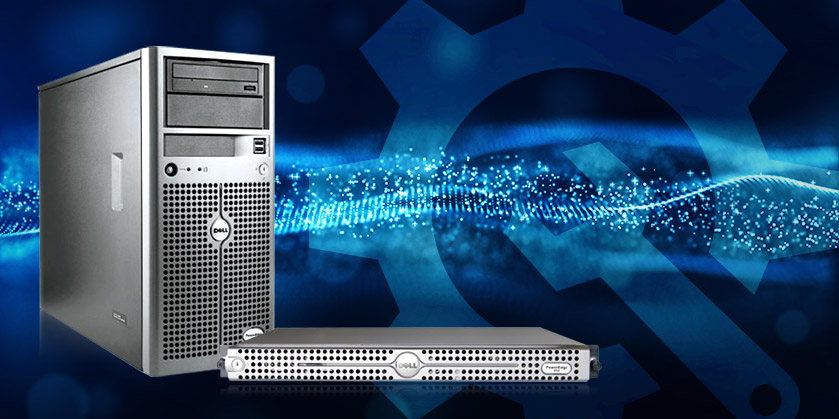Dell PowerEdge 840 and 860: It’s Time to Upgrade!

For several years, the Dell PowerEdge 840 and PowerEdge 860 servers have given small businesses the kind of processing power needed to help them meet whatever demands they faced. Offering the ideal alternative to the higher-priced and perhaps overpowered Intel series 5000 and 5100 dual-core processors, the PowerEdge twins entered the market with the respectable 3000 and 3200 series processors. This meant they were able to fulfill a pretty broad range of demands while still keeping ownership costs down.
Both the PowerEdge 840 and 860 checked the right boxes for the small business user. For starters, they had affordability on their side, and they featured Intel Xeon processors, allowing them to run multiple applications such as file serving, email and databases.
They also had small business-minded software preloaded, along with management tools to simplify administration and operations. The main difference between the two is that the 840 is a general purpose tower server, while the 860 is a 1U rackmount server, which made it a great option for those edge-of-network applications or when rack space was at a premium.
These servers made a lasting impression from the moment they made their debut; they offered better performance than their predecessors while at the same time consuming less power and providing a simplified setup. And they endeared themselves to small business owners in a big way.
Is It Time to Say Goodbye to Your Old Server?
Despite all the accolades and adulation earned by the PowerEdge duo, there comes a moment when it’s
time to let go. If you’re still working with a PowerEdge 840 or 860, there are several reasons you should start looking at newer options.
Keep in mind that these servers were released in 2006, which means that if they were your children, they’d be dangerously close to being able to drive. That’s a long time, especially in tech years. Technology’s rapid evolution means that, as innovative as these servers might have been when they were first rolled out, their functions are now limited. Newer servers have much greater memory and storage capabilities. Processing speed, which has become just as important as storage capacity, is much faster in a newer machine, allowing users to keep pace with the real-time analytics that the modern business environment depends on.
There’s also the concern about software and the compatibility of operating systems with servers that are nearing the 15-year mark. These platforms may no longer be supported or available, which limits the server’s functionality and ability to communicate with your other tech — all essential to your overall business operations. You might already have noticed an increase in the amount of money you’re spending on IT support; if you’re going to continue using an older server, you’re going to continue to see increases in your support costs.
And, if that’s not enough to make you consider retiring your PowerEdge, consider that working from an older and outdated server opens your business operations to security breaches. Threats are growing more sophisticated and complicated every year, and the more outdated your server is, the more vulnerable it is to ransomware, malware and other malicious attacks. Even patches become outdated rather quickly, so it will require constant monitoring for security breaches.
New Servers Step Up to the Challenge
The great news is that parting ways with your old server doesn’t have to mean it’s the end of that PowerEdge relationship. Two excellent upgrade options for your business are the PowerEdge
T130 and the PowerEdge T330 tower servers.
Like their predecessors, these PowerEdge models offer a good deal of flexibility for their size and have sufficient power to shoulder the workload of a small business. They share certain elements, such as an 8 GB installed memory (scalable to 64 GB), a 3 GHz Xeon processor and SATA hard drives. Both have DDR4 memory, which is 33% faster than the DDR3 it replaced. (By comparison, the PowerEdge 840 and 860 had DDR2.)
However, the T330 has a little bit more to offer than the T130, so you’ll want to compare features closely to make the right decision for your individual small business needs.
While both are excellent either as a first server or as your replacement server, the T330 offers more internal storage capacity with eight hard disk drives compared with the T130’s four HDDs. It also has two front 2.0 USB ports, an optical drive, six rear USB ports (two 3.0 and four 2.0) as well as two rear network ports.
For the small office/home office, or the small business looking at its first server, the T130 can do the job. It takes a more minimalistic approach in both design and options and has two USB ports — one 2.0 and one 3.0.
Which Server Option Is Right for You?
There are many variables in determining which server best suits your small business, mid-sized business or home office. Your workload, budget and usage are just a few of the things that factor into your overall decision. Creating a list of your business needs can help determine which server is best suited for you.
When it’s time to upgrade your server, Aventis Systems can help answer questions and provide the expertise you need to choose the server that is right for you today and is able to grow with your business tomorrow.
Recommended Reading:
|